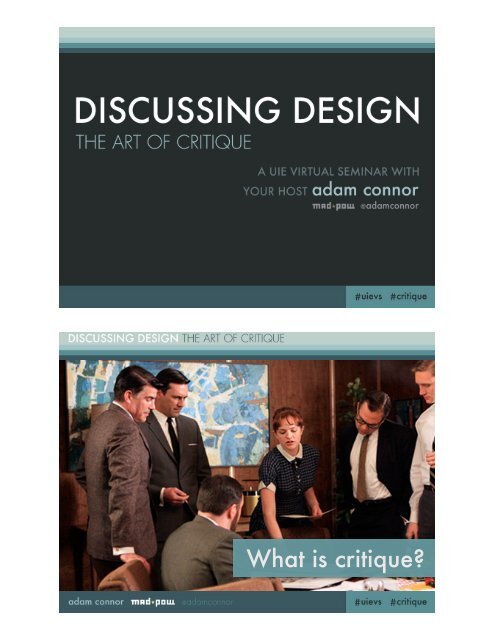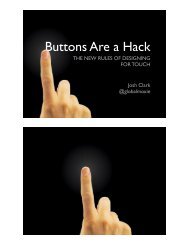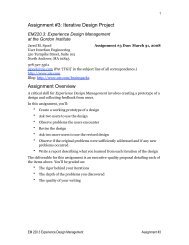What is critique?
What is critique?
What is critique?
You also want an ePaper? Increase the reach of your titles
YUMPU automatically turns print PDFs into web optimized ePapers that Google loves.
<strong>What</strong> <strong>is</strong> <strong>critique</strong>?
Critique <strong>is</strong> about critical thinking.<br />
There are two facets to <strong>critique</strong>:<br />
giving and receiving.<br />
At their foundation <strong>is</strong> intent.
Giving <strong>critique</strong> with the<br />
right intent <strong>is</strong> selfless.<br />
Giving <strong>critique</strong> with the<br />
wrong intent <strong>is</strong> self<strong>is</strong>h.
Tips for giving <strong>critique</strong>...<br />
Tips for giving <strong>critique</strong>...<br />
•Use a filter.<br />
Gather initial thoughts and reactions. Rev<strong>is</strong>it them in the right context.
Tips for giving <strong>critique</strong>...<br />
•Use a filter.<br />
Gather initial thoughts and reactions. Rev<strong>is</strong>it them in the right context.<br />
•Don’t assume.<br />
Find out the reason behind thinking, constraints or other variables.<br />
Tips for giving <strong>critique</strong>...<br />
•Use a filter.<br />
Gather initial thoughts and reactions. Rev<strong>is</strong>it them in the right context.<br />
•Don’t assume.<br />
Find out the reason behind thinking, constraints or other variables.<br />
•Don’t invite yourself.<br />
Get in touch and ask to chat about the design.
Tips for giving <strong>critique</strong>...<br />
•Use a filter.<br />
Gather initial thoughts and reactions. Rev<strong>is</strong>it them in the right context.<br />
•Don’t assume.<br />
Find out the reason behind thinking, constraints or other variables.<br />
•Don’t invite yourself.<br />
Get in touch and ask to chat about the design.<br />
•Lead with questions.<br />
Show an interest in their process.<br />
Receiving <strong>critique</strong> with the right intent<br />
takes humility and meekness.
Tips for receiving <strong>critique</strong>...<br />
Tips for receiving <strong>critique</strong>...<br />
•Remember the purpose.<br />
Critique <strong>is</strong> about understanding and improvement, not judgement.
Tips for receiving <strong>critique</strong>...<br />
•Remember the purpose.<br />
Critique <strong>is</strong> about understanding and improvement, not judgement.<br />
•L<strong>is</strong>ten and think before you talk back.<br />
Do you understand what the critics are saying?<br />
Tips for receiving <strong>critique</strong>...<br />
•Remember the purpose.<br />
Critique <strong>is</strong> about understanding and improvement, not judgement.<br />
•L<strong>is</strong>ten and think before you talk back.<br />
Do you understand what the critics are saying?<br />
•Refer to the goals.<br />
Is what you’re hearing pertinent to the goals you’re trying to achieve?
Tips for receiving <strong>critique</strong>...<br />
•Remember the purpose.<br />
Critique <strong>is</strong> about understanding and improvement, not judgement.<br />
•L<strong>is</strong>ten and think before you talk back.<br />
Do you understand what the critics are saying?<br />
•Refer to the goals.<br />
Is what you’re hearing pertinent to the goals you’re trying to achieve?<br />
•Participate.<br />
Analyze your proposed solution with everyone else.<br />
Critique <strong>is</strong> a life skill...<br />
...not a design skill.
Making <strong>critique</strong> part of your process...<br />
Making <strong>critique</strong> part of your process...<br />
•Standalone Critiques<br />
•Brainstorms and Collaborative Activities<br />
•Design “Reviews”
A few things to keep in mind...<br />
A few things to keep in mind...<br />
•Critique <strong>is</strong> a skill. You only get better<br />
with practice
A few things to keep in mind...<br />
•Critique <strong>is</strong> a skill. You only get better<br />
with practice<br />
•Start small<br />
A few things to keep in mind...<br />
•Critique <strong>is</strong> a skill. You only get better<br />
with practice<br />
•Start small<br />
•Think before you speak
A few things to keep in mind...<br />
•Critique <strong>is</strong> a skill. You only get better<br />
with practice<br />
•Start small<br />
•Think before you speak<br />
•Choose who you <strong>critique</strong> with<br />
carefully<br />
The Rules of Critique
The Rules of Critique<br />
•Avoid problem solving<br />
and design dec<strong>is</strong>ions.<br />
The Rules of Critique<br />
•Avoid problem solving<br />
and design dec<strong>is</strong>ions.<br />
•The designer <strong>is</strong><br />
responsible for follow<br />
up and dec<strong>is</strong>ions.
The Rules of Critique<br />
•Avoid problem solving<br />
and design dec<strong>is</strong>ions.<br />
•The designer <strong>is</strong><br />
responsible for follow<br />
up and dec<strong>is</strong>ions.<br />
•Everyone <strong>is</strong> equal.<br />
The Rules of Critique<br />
•Avoid problem solving<br />
and design dec<strong>is</strong>ions.<br />
•The designer <strong>is</strong><br />
responsible for follow<br />
up and dec<strong>is</strong>ions.<br />
•Everyone <strong>is</strong> equal.<br />
•Everyone <strong>is</strong> a critic.
Goals are critical for successful <strong>critique</strong>.<br />
Making <strong>critique</strong> part of your process...<br />
•Standalone Critiques<br />
•Brainstorms and Collaborative Activities<br />
•Design “Reviews”
Making <strong>critique</strong> part of your process...<br />
Standalone Critiques<br />
Why they’re awesome:<br />
Making <strong>critique</strong> part of your process...<br />
Standalone Critiques<br />
Why they’re awesome:<br />
•Introduction to people unfamiliar with <strong>critique</strong>
Making <strong>critique</strong> part of your process...<br />
Standalone Critiques<br />
Why they’re awesome:<br />
•Introduction to people unfamiliar with <strong>critique</strong><br />
• Safe(r) place to practice giving and receiving<br />
feedback<br />
Making <strong>critique</strong> part of your process...<br />
Standalone Critiques<br />
Why they’re awesome:<br />
•Introduction to people unfamiliar with <strong>critique</strong><br />
• Safe(r) place to practice giving and receiving<br />
feedback<br />
• Focus feedback on specific goals/topics/etc.
Making <strong>critique</strong> part of your process...<br />
Standalone Critiques<br />
Why they’re awesome:<br />
•Introduction to people unfamiliar with <strong>critique</strong><br />
• Safe(r) place to practice giving and receiving<br />
feedback<br />
• Focus feedback on specific goals/topics/etc.<br />
Two approaches: Impromptu and Scheduled<br />
Who should<br />
you invite?
When should you have <strong>critique</strong>s?<br />
All the time!
<strong>What</strong> should you <strong>critique</strong>?<br />
Everything!
When and what should you be critiquing?<br />
In the beginning of a project...<br />
When and what should you be critiquing?<br />
In the beginning of a project...<br />
<strong>What</strong> You’re Working On<br />
•High level user & business goals<br />
•User research, competitive analys<strong>is</strong><br />
•Initial concepts & v<strong>is</strong>ion
When and what should you be critiquing?<br />
In the beginning of a project...<br />
<strong>What</strong> You’re Working On<br />
•High level user & business goals<br />
•User research, competitive analys<strong>is</strong><br />
•Initial concepts & v<strong>is</strong>ion<br />
Example Goals<br />
•Feedback on different concepts / approaches<br />
•Explore the design of competing products<br />
When and what should you be critiquing?<br />
In the beginning of a project...<br />
<strong>What</strong> You’re Working On<br />
•High level user & business goals<br />
•User research, competitive analys<strong>is</strong><br />
•Initial concepts & v<strong>is</strong>ion<br />
Example Goals<br />
•Feedback on different concepts / approaches<br />
•Explore the design of competing products<br />
<strong>What</strong> You Might Look At<br />
•Competitors products<br />
•Conceptual models/sketches/flows
When and what should you be critiquing?<br />
In the middle of a project...<br />
When and what should you be critiquing?<br />
In the middle of a project...<br />
<strong>What</strong> You’re Working On<br />
•Detailed interactions & product behaviors<br />
•Identifying flow variations & solving for constraints
When and what should you be critiquing?<br />
In the middle of a project...<br />
<strong>What</strong> You’re Working On<br />
•Detailed interactions & product behaviors<br />
•Identifying flow variations & solving for constraints<br />
Example Goals<br />
•Compare the design of system components<br />
•Identify usability <strong>is</strong>sues<br />
•Get cross-functional team feedback<br />
When and what should you be critiquing?<br />
In the middle of a project...<br />
<strong>What</strong> You’re Working On<br />
•Detailed interactions & product behaviors<br />
•Identifying flow variations & solving for constraints<br />
Example Goals<br />
•Compare the design of system components<br />
•Identify usability <strong>is</strong>sues<br />
•Get cross-functional team feedback<br />
<strong>What</strong> You Might Look At<br />
•Screen-flow diagrams<br />
•Wireframes / Prototypes
When and what should you be critiquing?<br />
At the end of a project...<br />
When and what should you be critiquing?<br />
At the end of a project...<br />
<strong>What</strong> You’re Working On<br />
•Finalizing detailed design<br />
•Solidify answers or solutions to <strong>is</strong>sues
When and what should you be critiquing?<br />
At the end of a project...<br />
<strong>What</strong> You’re Working On<br />
•Finalizing detailed design<br />
•Solidify answers or solutions to <strong>is</strong>sues<br />
Example Goals<br />
•Analyze design details and the product’s full impact<br />
•Identify usability <strong>is</strong>sues<br />
•Get cross-functional team feedback<br />
When and what should you be critiquing?<br />
At the end of a project...<br />
<strong>What</strong> You’re Working On<br />
•Finalizing detailed design<br />
•Solidify answers or solutions to <strong>is</strong>sues<br />
Example Goals<br />
•Analyze design details and the product’s full impact<br />
•Identify usability <strong>is</strong>sues<br />
•Get cross-functional team feedback<br />
<strong>What</strong> You Might Look At<br />
•High Fidelity Prototypes<br />
•Beta/Pilot Systems
Preparation and Kickoff<br />
Tools & Techniques
Tools & Techniques<br />
•Active l<strong>is</strong>tening,<br />
Question for clarity<br />
Tools & Techniques<br />
•Active l<strong>is</strong>tening,<br />
Question for clarity<br />
•Round Robin
Tools & Techniques<br />
•Active l<strong>is</strong>tening,<br />
Question for clarity<br />
•Round Robin<br />
•Direct Inquiry<br />
Tools & Techniques<br />
•Active l<strong>is</strong>tening,<br />
Question for clarity<br />
•Round Robin<br />
•Direct Inquiry<br />
•Quotas
Tools & Techniques<br />
•Active l<strong>is</strong>tening,<br />
Question for clarity<br />
•Round Robin<br />
•Direct Inquiry<br />
•Quotas<br />
•Six Thinking Hats<br />
Tools & Techniques<br />
•Active l<strong>is</strong>tening,<br />
Question for clarity<br />
•Round Robin<br />
•Direct Inquiry<br />
•Quotas<br />
•Six Thinking Hats<br />
•Facilitators
Dealing with difficult people...<br />
Tips for “dealing with” difficult people...
Tips for “dealing with” difficult people...<br />
•Set expectations at the beginning<br />
Tips for “dealing with” difficult people...<br />
•Set expectations at the beginning<br />
•Make sure everyone understands <strong>critique</strong>
Tips for “dealing with” difficult people...<br />
•Set expectations at the beginning<br />
•Make sure everyone understands <strong>critique</strong><br />
•Ask quiet people for feedback directly<br />
Tips for “dealing with” difficult people...<br />
•Set expectations at the beginning<br />
•Make sure everyone understands <strong>critique</strong><br />
•Ask quiet people for feedback directly<br />
•Refer back to personas, goals and principles
Tips for “dealing with” difficult people...<br />
•Set expectations at the beginning<br />
•Make sure everyone understands <strong>critique</strong><br />
•Ask quiet people for feedback directly<br />
•Refer back to personas, goals and principles<br />
•Laddering / The 5 Whys<br />
Tips for “dealing with” difficult people...<br />
•Set expectations at the beginning<br />
•Make sure everyone understands <strong>critique</strong><br />
•Ask quiet people for feedback directly<br />
•Refer back to personas, goals and principles<br />
•Laddering / The 5 Whys<br />
•Critique with people individually ahead of time
Following Up<br />
Making <strong>critique</strong> part of your process...<br />
Design “Reviews”
Making <strong>critique</strong> part of your process...<br />
Design “Reviews”<br />
Challenges:<br />
•Used to get approval or some kind of “blessing”<br />
Making <strong>critique</strong> part of your process...<br />
Design “Reviews”<br />
Challenges:<br />
•Used to get approval or some kind of “blessing”<br />
•Timing determined by project timeline
Making <strong>critique</strong> part of your process...<br />
Design “Reviews”<br />
Challenges:<br />
•Used to get approval or some kind of “blessing”<br />
•Timing determined by project timeline<br />
•Often too large of an audience and many have<br />
the wrong intent<br />
Making <strong>critique</strong> part of your process...<br />
Design “Reviews”<br />
Challenges:<br />
•Used to get approval or some kind of “blessing”<br />
•Timing determined by project timeline<br />
•Often too large of an audience and many have<br />
the wrong intent<br />
•Output, if not approval, <strong>is</strong> typically a l<strong>is</strong>t of<br />
specified changes
Making <strong>critique</strong> part of your process...<br />
Design “Reviews”<br />
<strong>What</strong> can you do about it?<br />
Making <strong>critique</strong> part of your process...<br />
Design “Reviews”<br />
<strong>What</strong> can you do about it?<br />
•Take control as much as possible.
Making <strong>critique</strong> part of your process...<br />
Design “Reviews”<br />
<strong>What</strong> can you do about it?<br />
•Take control as much as possible.<br />
•Recap the goals and principles of the design<br />
Making <strong>critique</strong> part of your process...<br />
Design “Reviews”<br />
<strong>What</strong> can you do about it?<br />
•Take control as much as possible.<br />
•Recap the goals and principles of the design<br />
•Use the same tools as you would for dealing with<br />
difficult people
Making <strong>critique</strong> part of your process...<br />
Design “Reviews”<br />
<strong>What</strong> can you do about it?<br />
•Take control as much as possible.<br />
•Recap the goals and principles of the design<br />
•Use the same tools as you would for dealing with<br />
difficult people<br />
•Don’t rely on them for <strong>critique</strong>. Be prepared to<br />
schedule a more focused session.<br />
Making <strong>critique</strong> part of your process...<br />
Brainstorms and Collaborative Activities
Making <strong>critique</strong> part of your process...<br />
Brainstorms and Collaborative Activities<br />
The problem<br />
•Lack focus<br />
Making <strong>critique</strong> part of your process...<br />
Brainstorms and Collaborative Activities<br />
The problem<br />
•Lack focus<br />
•Fail to generate more ideas than would be<br />
produced by a single contributor
Making <strong>critique</strong> part of your process...<br />
Brainstorms and Collaborative Activities<br />
The problem<br />
•Lack focus<br />
•Fail to generate more ideas than would be<br />
produced by a single contributor<br />
•Progress too quickly into a “group think” mentality<br />
Making <strong>critique</strong> part of your process...<br />
Brainstorms and Collaborative Activities<br />
Your Super Innovative Brainstorm Session
Making <strong>critique</strong> part of your process...<br />
Brainstorms and Collaborative Activities<br />
Your Super Innovative Brainstorm Session<br />
Making <strong>critique</strong> part of your process...<br />
Brainstorms and Collaborative Activities<br />
Divergent<br />
Thinking<br />
Your Super Innovative Brainstorm Session
Making <strong>critique</strong> part of your process...<br />
Brainstorms and Collaborative Activities<br />
Divergent<br />
Thinking<br />
Convergent<br />
Thinking<br />
Your Super Innovative Brainstorm Session<br />
Making <strong>critique</strong> part of your process...<br />
Brainstorms and Collaborative Activities<br />
Divergent<br />
Thinking<br />
Critique<br />
Convergent<br />
Thinking<br />
Your Super Innovative Brainstorm Session
In Summary<br />
•Critique <strong>is</strong> a life skill, not a design skill and only<br />
improves with practice.<br />
•Critique focuses on what works, what doesn’t<br />
and why. It’s analys<strong>is</strong>.<br />
•Intent <strong>is</strong> critical to the success of a <strong>critique</strong>, both<br />
in giving and receiving.<br />
In Summary<br />
•Learning to <strong>critique</strong> improves our ability to<br />
communicate with teams, clients and others.<br />
•Critique can be done both internally and with<br />
clients. Use 3-6 people for about 1 hour.<br />
•Clearly communicate the goals of a <strong>critique</strong><br />
session and ground rules to all participants.
Additional Resources<br />
• The Art of the Design Critique (Aarron Walter - Think Vitamin)<br />
http://thinkvitamin.com/design/the-art-of-the-design-<strong>critique</strong>/<br />
• Dealing with Design Critiques (Jacob Gube - Design Instruct)<br />
http://designinstruct.com/articles/project-management/dealing-with-design-<strong>critique</strong>s/<br />
• Design Critic<strong>is</strong>m and the Creative Process (Cassie McDaniel - A L<strong>is</strong>t Apart)<br />
http://www.al<strong>is</strong>tapart.com/articles/design-critic<strong>is</strong>m-creative-process/<br />
• Everything I’ve Ever Learned About Giving Design Critiques I Learned from Tim Gunn (Dan<br />
Saffer - Kicker Studio)<br />
http://www.kickerstudio.com/blog/2010/11/everything-ive-ever-learned-about-givingdesign-<strong>critique</strong>s-i-learned-from-tim-gunn/<br />
• <strong>What</strong> Goes into a Well-Done Critique (Jared Spool - UIE)<br />
http://www.uie.com/articles/<strong>critique</strong>/







